Native shrubs like Silky Dogwood, Common Elderberry, and Shrubby St. John’s Wort create effective erosion barriers with their extensive root systems. You’ll get dual benefits from flowering options such as Forsythia and Ninebark, which stabilize soil while adding visual interest. For slopes, fast-growing varieties quickly establish protection, while evergreens like Juniper provide year-round stabilization. Pair these with native grasses for a multi-tiered approach that strengthens over time and supports local wildlife.
Deep-Rooted Native Shrubs That Prevent Soil Runoff
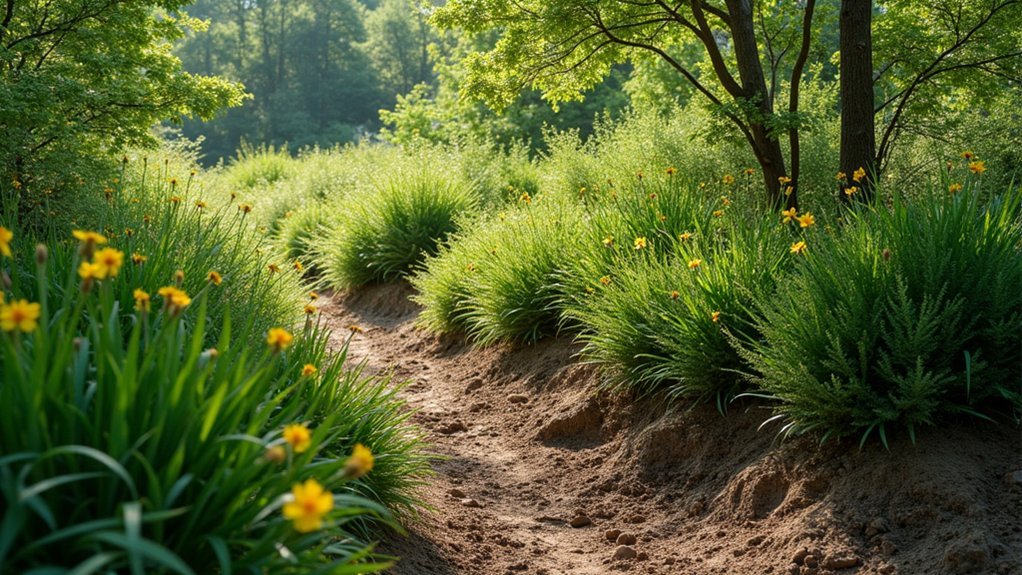
Three exceptional native shrubs stand out for their remarkable ability to combat soil erosion: Silky Dogwood, Common Elderberry, and Shrubby St. John’s Wort.
These deep-rooted native shrubs develop extensive root systems that excel at soil stabilization, particularly in erosion-prone areas like slopes and streambanks.
Native shrubs create natural armor against erosion with their extensive root networks, securing vulnerable terrain with remarkable efficiency.
When you plant these varieties, you’re leveraging their natural adaptation to local climate conditions. They require minimal maintenance while providing substantial erosion control benefits.
Their fibrous roots grip the soil firmly, preventing runoff during heavy rainfall and improving overall soil health.
What makes these shrubs particularly valuable is their ability to establish quickly, creating natural barriers that filter pollutants and enhance water infiltration.
For long-term protection against erosion, these native options offer the perfect balance of functionality and environmental benefit.
Flowering Shrubs for Dual-Purpose Erosion Control
While protecting your landscape from erosion is essential, you don’t have to sacrifice beauty for functionality. Flowering shrubs like Forsythia offer brilliant yellow blooms in early spring while their robust root systems provide excellent soil stabilization on slopes.
Consider Common Elderberry for its edible berries and powerful erosion control capabilities. Potentilla delivers vibrant flowers alongside effective soil retention through its extensive roots.
For versatility, plant Diervilla (Bush Honeysuckle), which thrives in various conditions while anchoring soil with deep roots. Ninebark shrubs showcase attractive flowers and unique foliage while their fibrous roots create natural barriers against soil erosion.
Fast-Growing Border Shrubs for Unstable Slopes
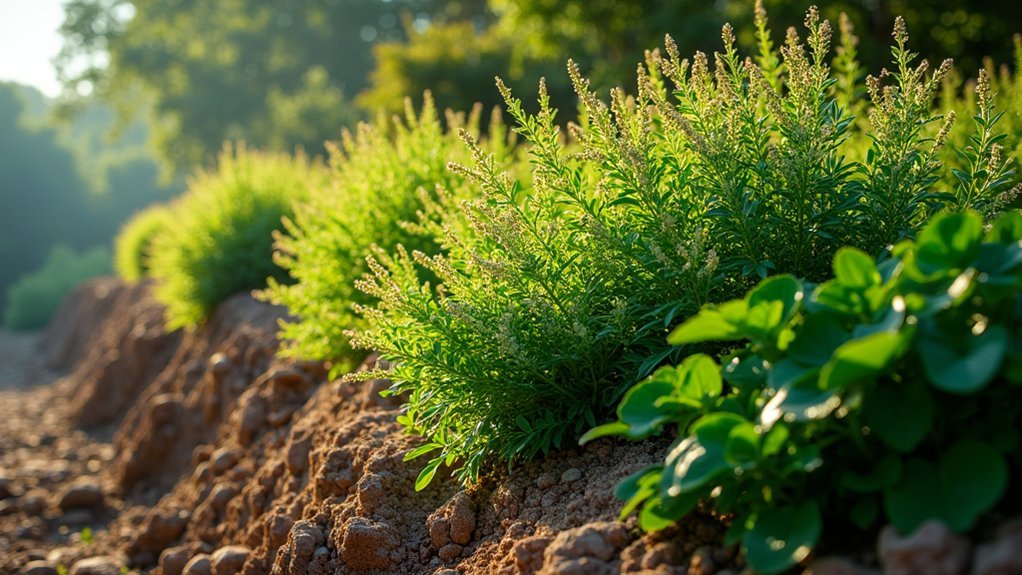
When tackling unstable slopes in your landscape, fast-growing border shrubs offer an ideal solution that combines rapid soil stabilization with aesthetic appeal.
Forsythia, with its tenacious root system, excels in zones 5-8, effectively preventing soil erosion on troublesome inclines.
For wet conditions, consider Silky Dogwood. This native shrub rapidly establishes fibrous roots that anchor soil on steep terrain.
Similarly, Common Elderberry provides excellent soil stability while producing wildlife-supporting berries.
Don’t overlook Shrubby St. John’s Wort, which develops deep roots that enhance soil structure on unstable slopes.
Its attractive foliage and flowers add visual interest to your erosion control strategy.
Evergreen Varieties for Year-Round Soil Stabilization
Your erosion-resistant landscape can benefit from evergreens that feature layered root systems extending both deep and wide to anchor soil effectively.
Consider drought-resistant options like Juniper and Bearberry that won’t require supplemental watering once established, even during extended dry periods.
These hardy varieties will continue stabilizing your slope through all seasons while requiring minimal maintenance, making them ideal long-term solutions for challenging terrain.
Layered Root Systems
Because they maintain their foliage throughout all seasons, evergreen shrubs offer superior erosion control with their complex layered root systems.
Species like Forsythia and Rockspray Cotoneaster develop extensive underground networks that effectively stabilize soil in challenging conditions, especially on slopes where erosion risk is highest.
The fibrous roots of these hardy plants prevent washout by anchoring deeply into various soil types, enhancing structural integrity while requiring minimal maintenance once established.
You’ll find options like Creeping Juniper adapt remarkably well to different environments, providing reliable protection against soil loss year after year.
Beyond their practical benefits, these evergreen shrubs create visual interest and provide habitat for wildlife.
Their persistent foliage works continuously to hold soil in place while delivering sustainable, long-term erosion management for your landscape.
Drought-Resistant Options
Drought-resistant evergreen shrubs offer exceptional erosion control while requiring minimal water once established.
Consider Creeping Junipers and Rockspray Cotoneaster, whose extensive root systems anchor soil year-round, making them ideal choices for slopes and erosion-prone areas.
These versatile evergreen shrubs thrive across diverse climate zones—Creeping Junipers excel in zones 3-9, while Rockspray Cotoneaster performs best in zones 5-7.
You’ll appreciate how their deep, fibrous roots retain moisture in the soil and minimize runoff, effectively stabilizing dry, sloped terrain.
For added landscape aesthetics, incorporate Forsythia varieties that combine erosion control with stunning spring blooms.
Drought-Tolerant Shrubs for Erosion-Prone Areas
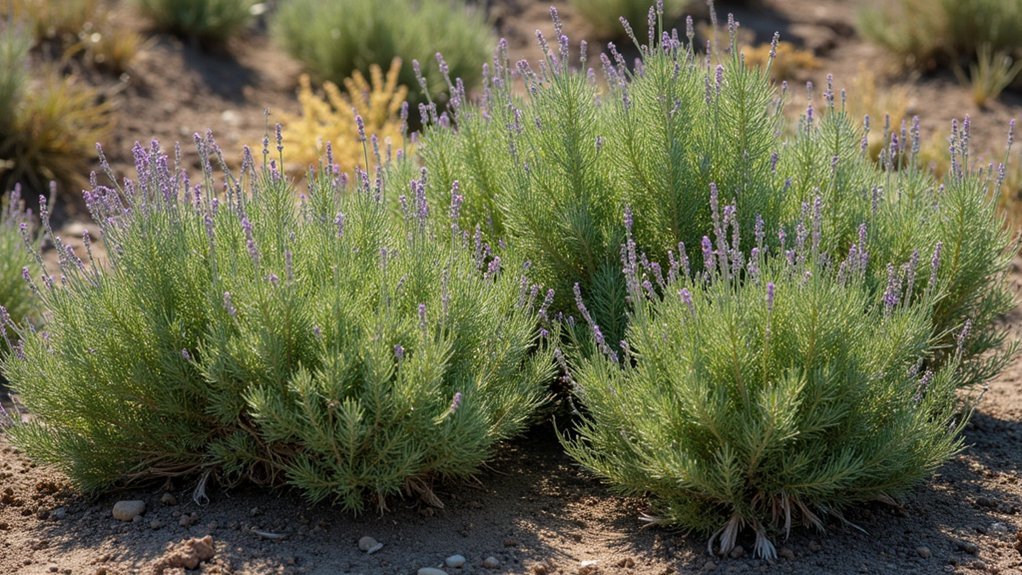
You’ll find moisture-retaining desert plants like Common Elderberry and Shrubby St. John’s Wort perfect for creating stable, drought-resistant barriers in arid landscapes.
Hillside hardy champions such as Silky Dogwood and Red Chokeberry establish extensive root systems that effectively bind soil on slopes while requiring minimal irrigation.
These resilient shrubs not only prevent erosion during dry spells but also add aesthetic value with their attractive foliage and seasonal blooms.
Moisture-Retaining Desert Plants
In regions where water scarcity meets erosion challenges, desert-adapted shrubs offer a powerful solution for stabilizing vulnerable landscapes.
Drought-tolerant shrubs like Creosote Bush develop deep root systems that effectively stabilize soil while creating natural erosion barriers in arid environments.
You’ll find that Red Yucca excels at moisture retention, promoting healthier root systems that combat erosion in desert settings.
The fast-growing Desert Willow provides both beautiful flowers and erosion control, making it doubly valuable for your landscape needs.
Consider pairing these shrubs with Little Bluestem grass for extensive ground coverage on slopes.
Sagebrush is another excellent choice, as its extensive root network binds soil efficiently while creating wildlife habitat—giving you multiple benefits beyond simple erosion control.
Hillside Hardy Champions
Steep slopes present three particular challenges that drought-tolerant shrubs are uniquely equipped to handle.
These native shrubs prevent soil erosion while requiring minimal maintenance in areas prone to water runoff.
- Silky Dogwood’s fibrous root systems excel at stabilizing hillsides while thriving in varying moisture conditions.
- Common Elderberry grows quickly on slopes, anchoring soil while attracting beneficial wildlife with edible berries.
- Shrubby St. John’s Wort’s deep roots secure unstable ground while adding visual appeal with attractive foliage.
- Native varieties naturally adapt to local climates, reducing water requirements while effectively controlling erosion.
- Pairing these erosion-fighters with companion grasses creates a multi-layered root network for maximum soil stability.
For best results, consider planting these hardy champions in strategic clusters where erosion risk is highest, especially along contours of steep terrain.
Multi-Season Performers: Shrubs With Extended Root Systems
While many gardeners focus solely on a plant’s aesthetic qualities, multi-season performers offer both beauty and powerful erosion control through their extensive root systems. Shrubs like Silky Dogwood and Common Elderberry work year-round, preventing soil displacement with their deep, fibrous roots that effectively bind soil particles together.
You’ll appreciate how these versatile plants thrive in both wet and dry conditions, making them ideal for various landscape challenges. Their root systems excel at reducing runoff while promoting water infiltration, creating a natural erosion barrier that strengthens over time.
Fast-growing native options establish quickly, providing immediate erosion control while helping support local wildlife and enhancing biodiversity.
Companion Planting Strategies With Native Erosion Barriers
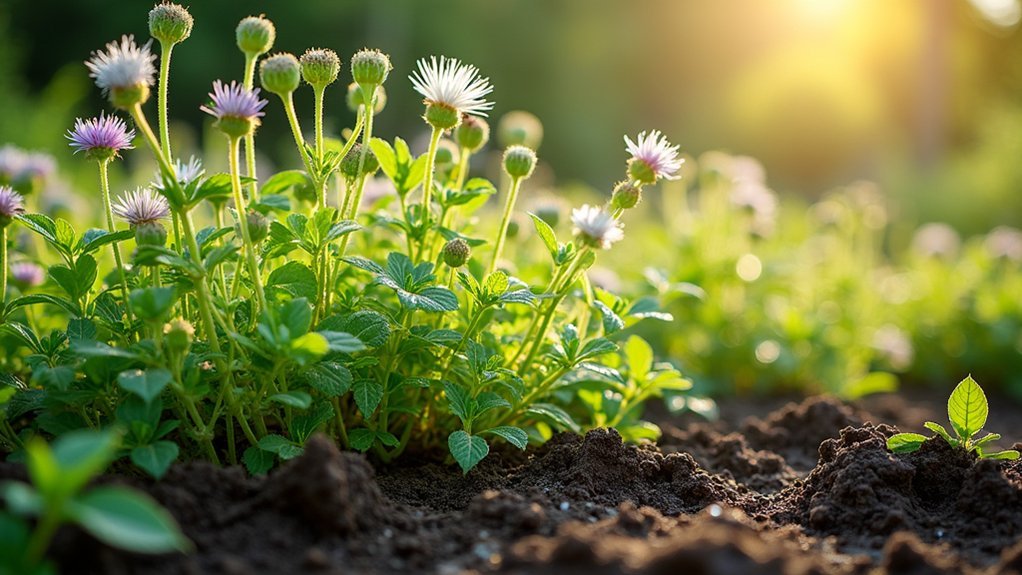
Native erosion barriers truly shine when thoughtfully paired with complementary plant species, creating a layered defense system against soil loss.
When you’re establishing erosion-resistant landscapes, strategically combining native shrubs with companion plants maximizes soil stability and ecological function.
- Pair Silky Dogwood or Common Elderberry with Little Bluestem grass to anchor soil effectively through diverse root structures.
- Plant wild ginger as ground cover beneath native shrubs to shield exposed soil from rainfall impact.
- Mix herbaceous natives with erosion-resistant shrubs to enhance water filtration and nutrient cycling.
- Create biodiversity zones by layering different plant heights around your native shrubs.
- Avoid invasive species that might outcompete your carefully selected native companions.
This multi-tiered approach creates resilient erosion barriers that not only prevent soil loss but also support healthy ecosystem functions throughout your landscape.
Frequently Asked Questions
What Is the Best Bush to Block Neighbors?
You’ll find Arborvitae ideal for blocking neighbors with its tall, narrow growth and year-round privacy. Privet and Forsythia are also excellent choices, growing quickly to form dense, visual barriers up to 10 feet tall.
What Is the Best Groundcover for a Steep Slope?
For steep slopes, you’ll find creeping junipers and phlox excellent for soil stabilization. Don’t overlook Vinca Minor in shady spots or forsythia for steeper areas—they’ll provide dense coverage while preventing erosion effectively.
What Type of Plants Prevent Soil Erosion?
You’ll find deep-rooted shrubs like Silky Dogwood, Common Elderberry, and Red Twigged Dogwood excellent for preventing soil erosion. Native flowering plants like Forsythia and Viburnum also stabilize soil with their extensive root systems.
What Is the Best Natural Erosion Control?
The best natural erosion control combines deep-rooted native shrubs, dense ground covers, and companion plants. You’ll get ideal results when you’re using a mixture of vegetation that creates multi-layered protection against soil displacement.
In Summary
When selecting erosion control shrubs, you’ll find that nature has already perfected the solution. Choose deep-rooted native varieties that match your climate conditions for best results. You don’t need to sacrifice beauty for function—many erosion-fighting shrubs offer stunning blooms, year-round interest, and drought tolerance. Remember, a thoughtfully planned mixture of species creates the most resilient natural barrier against soil loss.

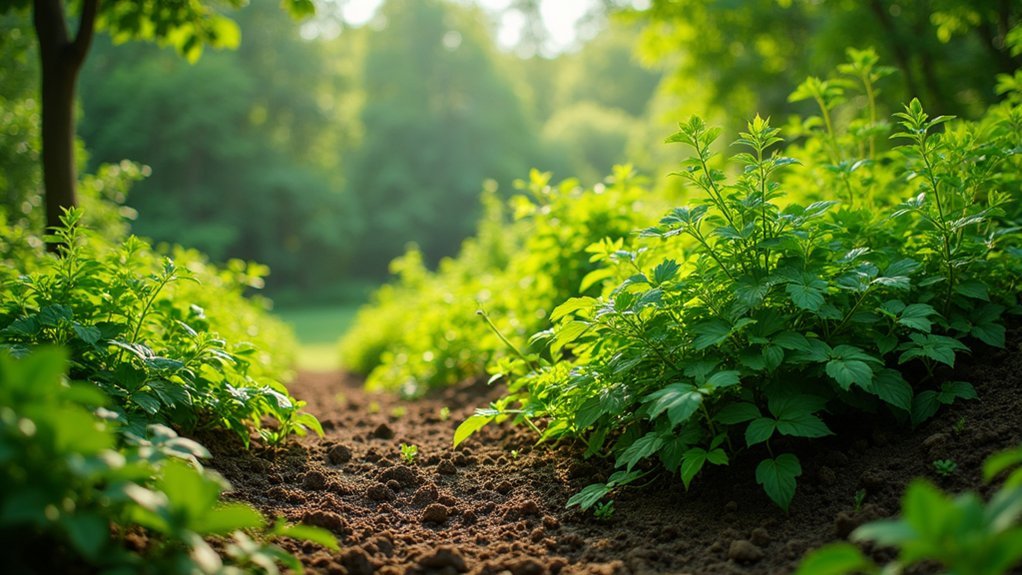

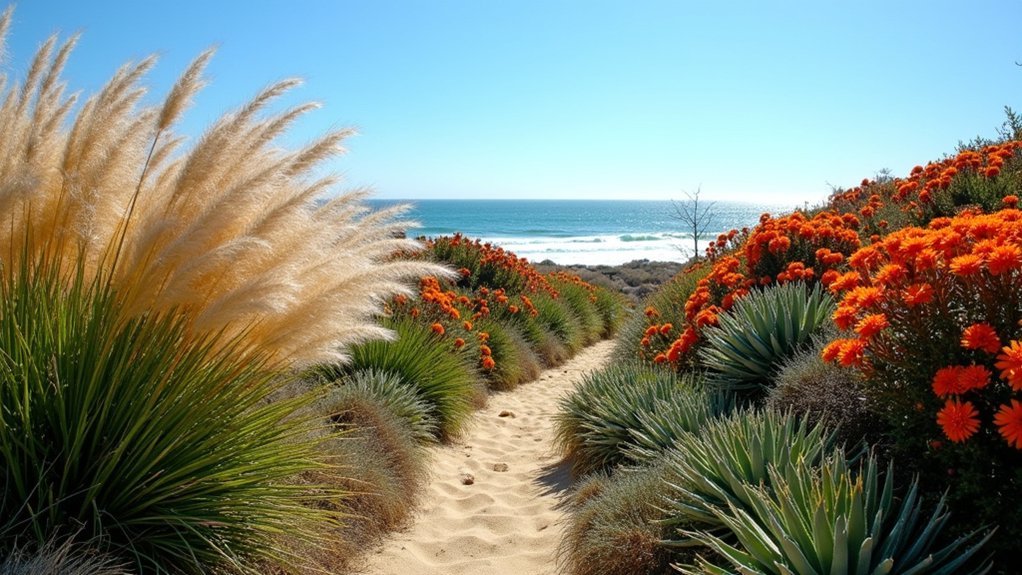
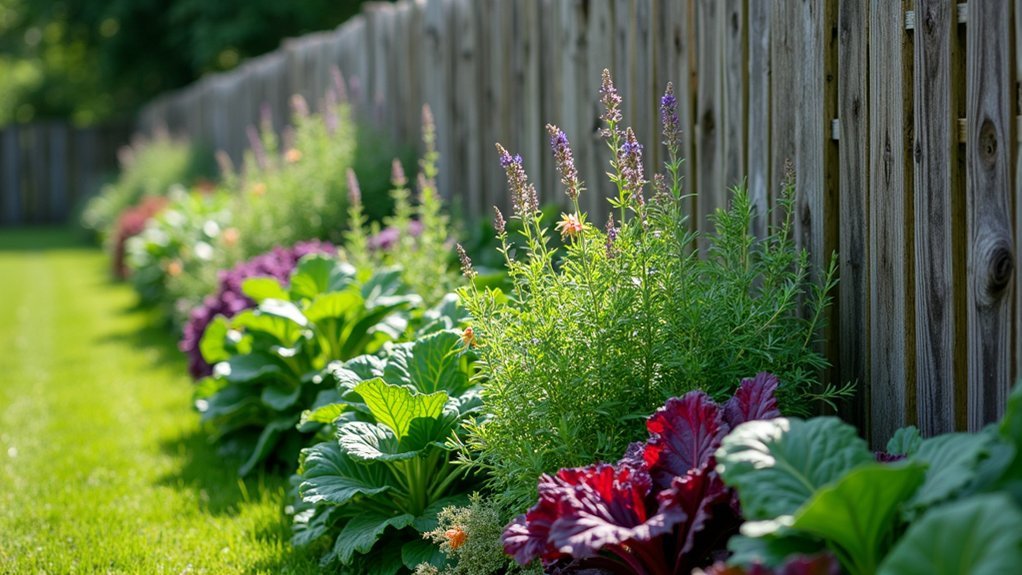
Leave a Reply